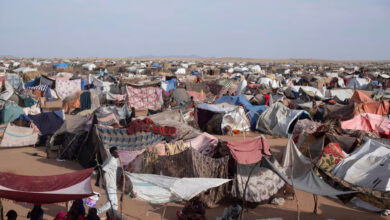KHARTOUM – North Sudan has massed what looks like a large convoy of troops in its Southern Kordofan oil state, the site of clashes that have threatened the peaceful secession of the south, a satellite monitoring group said on Wednesday.
The United Nations said both sides in the fighting had prevented its staff from visiting thousands of civilians caught up in the conflict and left humanitarian workers powerless and trapped in their compounds, according to an internal report seen by Reuters.
More than 73,000 civilians have fled since clashes between the northern army and south-linked forces started in early June in the northern oil-producing state that borders the south, according to UN reports.
The violence has clouded preparations for the independence of south Sudan, due to take place on Saturday, and raised fears that fighting could spread south over the border.
As Sudan prepares to lose its south, activists have accused Khartoum of trying to stamp its authority on rebellious areas left on the northern side of the border.
They say northern troops have been targeting civilians from the Nuba people, many of whom sided with the south during decades of civil war and want greater autonomy for their region. Khartoum has denied the allegations.
The northern government has accused officials from the northern branch of south Sudan's governing party – the Sudan People's Liberation Movement (SPLM) – of launching an uprising to try and seize control of the state ahead of the secession.
Media access is restricted in the state and it has not been possible to independently confirm the reports, but senior northern official Rabie Abdelati denied there was a new troop build-up.
"There is no justification in saying the government is targeting civilians. It is targeting the rebels and they are the ones who are terrorising civilians. The government's responsibility is to achieve security and peace," he told Reuters.
The US-based Satellite Sentinel Project said it had identified "an apparent convoy of Sudan Armed Forces (northern army) vehicles and towed artillery, stretching over two kilometers and consistent with an infantry unit of at least regiment size – equal to approximately 1,000 troops" in the state capital Kadugli, in pictures taken on Monday.
The satellite body, backed by the Enough Project, other activist groups and Hollywood actor George Clooney, said other images showed military aircraft, including two helicopter gunships, signs that a northern military base in Kadugli had been reinforced and rocket launchers near the state's Nuba Mountains area.
"The Sudanese regime appears to be ignoring its commitment, holding to form, and positioning military assets for intensified offensive operations," said Enough Project co-founder John Prendergast in a statement.
An internal UN report, dated June 30, said its staff had not been able to monitor the fighting. "Rather than observe and monitor the movement of regular forces and armed groups we have been confined to our camps by these very entities," said the report.
Southern Kordofan is important to the north because it has the most productive oil fields that will remain under Khartoum's control after the split. The south could take as much as 75 percent of Sudan's 500,000 barrels per day of oil output.
Southerners overwhelmingly voted to declare independence in a January referendum, a vote that was the climax of a 2005 peace deal that ended the last north/south civil war.
The SPLM has warned the South that fighting in Kordofan could spark a coordinated uprising against Khartoum in other states on the northern side of the border, chiefly Blue Nile and Darfur, the site of a separate eight-year insurgency.




